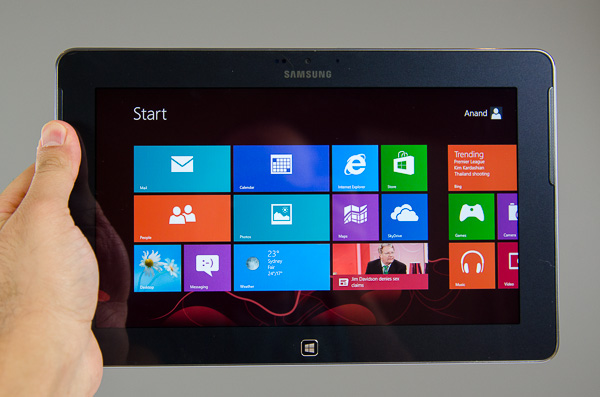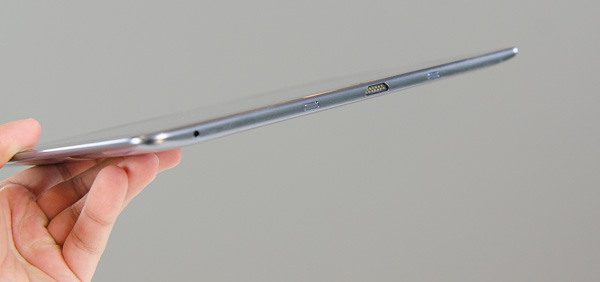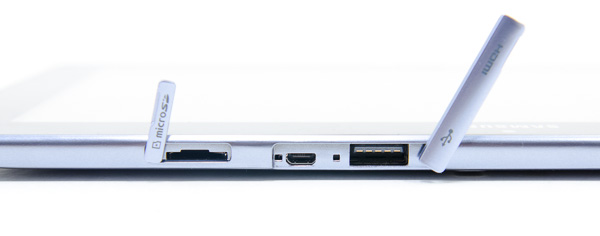Samsung ATIV Tab Review: Qualcomm's First Windows RT Tablet
by Anand Lal Shimpi on January 3, 2013 6:00 AM EST- Posted in
- Tablets
- Samsung
- Qualcomm
- Mobile
- Windows RT
I remember writing Intel and telling them that, from a tablet perspective, the Windows 8 launch might as well have been a Windows RT launch. By the time October 23rd rolled around, the only Windows tablets we had in for review were ARM based and running Windows RT. I even resorted to borrowing an unfinished Clover Trail tablet just so we’d have something to put Surface RT’s performance in perspective at launch.
Clover Trail was late by about a month to the Windows 8 launch. Most of the traditional PC partners were delayed either by Intel or by burdens of their own. As much as we wished Surface RT would’ve launched with a different SoC, truth be told I don’t know that anyone else outside of NVIDIA could’ve met the aggressive schedule that Microsoft set. Qualcomm and TI were both design partners working on Windows RT devices, but neither of them had solutions available at launch.
Now that we’re two months out from launch however, things are starting to change. We’ve already reviewed one of the first Clover Trail tablets, with another on the way. And just before the holidays last year, this thing showed up:
It may look like the Samsung ATIV Smart PC that Vivek is working on, but it’s the smaller 10.1-inch ATIV Tab featuring Qualcomm’s APQ8060A SoC. Yep, this is the first Windows RT tablet we have in house to use Qualcomm silicon.
In the phone space, Qualcomm’s Krait based SoCs have generally been the preferred platform. Using TSMC’s 28nm LP process, they’ve offered better power consumption than NVIDIA’s 40nm LPG Tegra 3. The 2 Krait cores housed in the more popular of these SoCs (MSM8960), at least in phones, generally delivered better performance than the NVIDIA alternative as well. But that was in the Android space - would things be any different on a Windows RT tablet? With an inherently more multitasking friendly device and OS, would NVIDIA’s quad-core approach trump Qualcomm’s pair-of-faster-cores? And what about battery life? Tegra 3 did remarkably well in Surface RT, but how would Qualcomm fare?
Armed with Samsung’s ATIV Tab, I tried to find out.
The Tab
As with most of Samsung’s tablet designs, the ATIV Tab is a tablet built out of plastic and glass. The design and feel aren’t bad, but they’re nothing particularly new or exciting. The big benefit of the plastic chassis is of course weight. The ATIV Tab weighs in at 572g compared to 688g for Surface RT, it’s around the same weight as the Acer W510 we reviewed a couple of weeks ago. The light weight means carrying it around is quite pleasant. And despite the plastic construction, build quality is solid. I noticed no creaks or unsettling flexibility in the chassis.
Internally there's a Qualcomm APQ8060A SoC (dual-core Krait running at up to 1.5GHz + Adreno 225, no integrated baseband) paired with 2GB of LPDDR2 memory. It is a bit surprising that Samsung/Qualcomm didn't opt to launch with APQ8064 (quad-core Krait), but I suspect this was a decision made more out of time to market than anything else.

On the storage side there's either a 32GB or 64GB eMMC solution soldered down on the board. Remember that Windows RT comes preinstalled with a full version of Office 2013 Home & Student Edition. After Samsung's preinstalled apps a 32GB ATIV Tab shows up with around 14.1GB of free space.
The ATIV Tab’s 10.1-inch 1366 x 768 display makes for a familiarly portable form factor. While the Smart PC’s 11.6-inch form factor makes for a better notebook, the ATIV Tab seems to be a better tablet.
Like the Clover Trail version, the ATIV Tab is littered with plastic doors over nearly every port around the perimeter of the device. Along the top the micro HDMI and full USB 2.0 port are behind a door, as is the microSD card slot. The doors do help maintain a smooth edge, but I’m not a fan of them.
Headphone jack, power/lock and volume up/down are also along the top of the tablet. There's no rotation lock button on the ATIV Tab. There's a physical Windows button on the front face of the tablet.
The sides are devoid of any intrusions into the ATIV Tab’s design, while the bottom edge features the charge port as well what looks like a dock connector. My review sample didn't come with a dock and Samsung's website doesn't seem to list any keyboard dock accessory for the ATIV Tab, so for now this port goes unused.
There are a pair of reasonably loud (for a tablet) stereo speakers that border the display, while front (1.9MP) and rear (5MP) cameras complete the package for Samsung.
| Tablet Specification Comparison | ||||||||
| Samsung ATIV Tab | Apple iPad 4 | Google Nexus 10 | Microsoft Surface RT | Samsung ATIV Smart PC | ||||
| Dimensions | 10.46 x 6.62 x 0.35" | 9.5 x 7.31 x 0.37" | 10.39 x 6.99 x 0.35" | 10.81 x 6.77 x 0.37" | 11.97 x 7.46 x 0.39" | |||
| Display | 10.1-inch 1366 x 768 IPS | 9.7-inch 2048 x 1536 IPS | 10.1-inch 2560 x 1600 PLS | 10.6-inch 1366 x 768 PLS | 11.6-inch 1366 x 768 PLS | |||
| Weight | 1.26 lbs | 1.44 lbs (WiFi) | 1.33 lbs | 1.5 lbs | 1.64 lbs | |||
| Processor | Qualcomm APQ8060A (2 x 1.5GHz Krait, Adreno 225) |
Apple A6X (2 x Swift, PowerVR SGX 554MP4) |
Samsung Exynos 5 Dual |
NVIDIA Tegra 3 |
Intel Atom Z2760 (2 x 1.8GHz Atom, PowerVR SGX 545) | |||
| Connectivity | WiFi | WiFi , Optional 4G LTE | WiFi | WiFi | WiFi , Optional 4G LTE | |||
| Memory | 2GB | 1GB | 2GB | 2GB | 2GB | |||
| Storage | 32-64GB | 16GB—64GB | 16GB or 32GB | 32GB or 64GB | 64GB | |||
| Battery | 30.0Wh | 42.5Wh | 33.75Wh | 31.5Wh | 30.0Wh | |||
| Starting Price | $499? | $499 | $399 | $499 | $599 | |||
The more I use other Windows RT/8 tablets, the more I'm realizing that the stability issues I encountered with Acer's W510 are more a function of that tablet and less a general Microsoft problem. Although I did experience a couple of unexpected app crashes, the overall experience with Samsung's ATIV Tab was positive. I didn't see anywhere near the number of cases of strange behavior as I did with the W510. I'm beginning to wonder if Clover Trail's Windows 8 software stack isn't as mature as the Windows RT implementations that I've played with.














42 Comments
View All Comments
Tech-Curious - Thursday, January 3, 2013 - link
Well said.Especially this bit.
MonkeyPaw - Thursday, January 3, 2013 - link
Actually, once you use a nice high-Res device, it is quite difficult to go back to a cheap panel. My vision is by no means great, but the difference between a TF300T and a TF700T is quite noticeable.More to the current weakness of Windows 8--they need to get auto-correct going. So far, the touch keyboard is just that. MS just seems behind on system-wide text entry advancements.
Tech-Curious - Thursday, January 3, 2013 - link
I'm not saying that a higher resolution can't improve your subjective experience on a very small screen -- but at the screen size we're discussing, the difference is nebulous, undefinable.(The high-res panel might also have better color fidelity or a better contrast ratio, for example. Resolution isn't the only determinant of image quality -- and by definition, resolution becomes less determinant as screen size dwindles.)
High resolution is a luxury, and as BrokenCrayons points out, it's a costly luxury. To me, the benefit of a larger resolution is more than offset by the performance penalty. A tablet with a high-res screen will tend to cost more, and it will tend to age faster than a lower-res analogue. After all, your TF700T has to draw 222% more pixels than your TF300T. (2.28 million versus 1.024 million.)
Do you really think the TF700T looks 222% better? If you'd never used the TF700T, would the display on the TF300T bother you at all? The inferior tablet in your example boasts a pixel density 10% higher than the pixel density of the perfectly serviceable desktop monitor on which I'm typing this post, BTW.
As usual, the matter boils down to a value proposition. Of course a higher-resolution screen is better than a lower-resolution screen, all else being equal, but people on any kind of budget should consider how well a given resolution fits into their budget, both now and in the future. I say the same thing about desktop rigs; if you're a gamer, for example, and you get yourself accustomed to ultra-high-res and/or multi-monitor gaming, then you are signing yourself up for a very expensive hobby. You may only have to buy the monitor(s) once, but you're gonna have to keep shelling out for high-end video cards to accommodate it (them).
On the other hand, someone who is accustomed to (and content with) lower-resolution gaming can wring an immense amount of value out of their computer hardware. Likewise, a consumer who's content with less-than-preposterous resolutions on a tablet will wring more value out of his tablets. He'll feel compelled to upgrade less often, which is probably the reason tablet manufacturers are pushing high-res screens so hard lately. ;)
Tech-Curious - Thursday, January 3, 2013 - link
(That should say, "your TF700T has to draw 122% more pixels than the TF300T." The former has 222% as many pixels as the latter, not 222% more pixels. :)Tech-Curious - Thursday, January 3, 2013 - link
All of that said, and whether you think a high-res tablet display is worth it or not, I think we can agree that killerclick's original, disparaging comment ("LOL @ 1366x768") was unwarranted given the size of the screen we're discussing.MonkeyPaw - Friday, January 4, 2013 - link
In my search to replace my Iconia A500, I tried a W510, TF300T, and the TF700T. I am normally a value shopper too, but the older I get, the more my definition of value changes. I used my last tablet every day, almost exclusively at home, and I don't play FPS games on a tablet. It's not IF the screen is some quantitative amount better, it is if the clearly better screen is worth the extra cost. Considering you also get faster internals and better build quality for an additional $70, I'd say it's worth it. I didn't find that much variation in battery life, and the TF700T lasts "all day" and charges in a couple hours. I used 5% of my battery in 40 minutes of web browsing this morning.Tech-Curious - Friday, January 4, 2013 - link
I'm glad you're happy with your purchase. To clarify, it was never my intention to criticize the TF700T as a bad value in total. I'm actually a bit of an ASUS fanboy.As you point out, there's more to the product than just the screen's resolution. My only point is that high resolution is a burden on the rest of the system. Like BrokenCrayons, I question how much practical use the consumer gets out of 1900x1200 on a 10.1" screen.
ninjacut - Thursday, January 3, 2013 - link
Its absolutely worth the price, considering it runs a full OS and not a Phone OS. If you compare the footprint, WP8 has same size has Android or iOS.Now add multi-user, desktop, office, file system, network share, with desktop grade utilities like power shell, explorer, task manager, disk manager, etc. etc. etc then obviously the footprint will be large.
Is that too difficult to realize?
mayankleoboy1 - Thursday, January 3, 2013 - link
Anand, both SunSpider and Kraken are outdated benchmarks. Browsers have optimisations for them, which doesnt translate into real world performance.The best benchmark is the "Google Octane". It consist of all real world tests.
DanNeely - Thursday, January 3, 2013 - link
Any idea when this will be finished? We've seen battery results a few weeks ago alongside the Acer 510 review; and you've added CPU/GPU numbers on it in this review. What's left to do before the writeup?